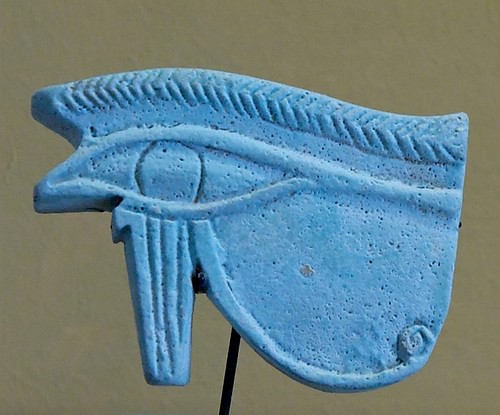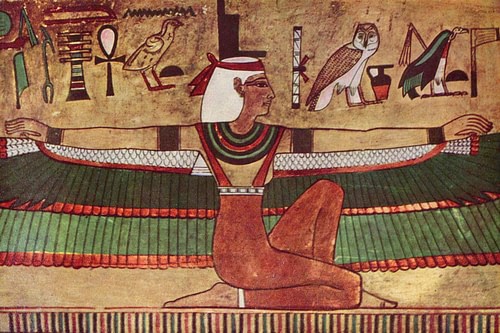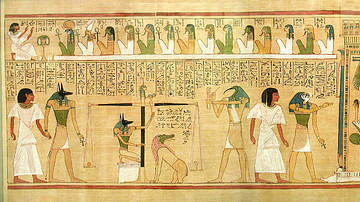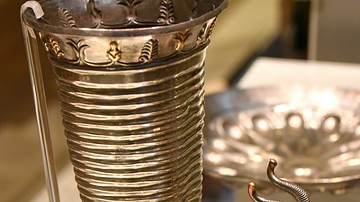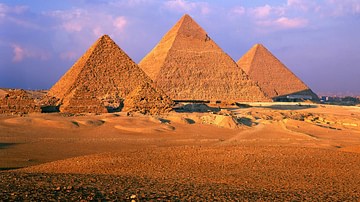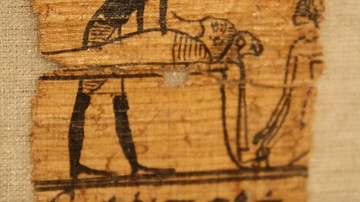The ancient Egyptians had a great appreciation for life which is clearly depicted through their art. Images of people enjoying themselves - whether in this life or the next - are as plentiful as those most often seen of the gods or funerary rituals. The early Egyptologists who first encountered the culture focused their attention on the many examples of funerary art found in tombs and concluded that Egyptian culture was death-obsessed when, in reality, the ancient Egyptians were wholly absorbed in living life to its fullest.
Egyptians decorated their homes, gardens, palaces, and tombs with impressive works of art which reflected their appreciation for all that the gods had given them and accented these depictions with vibrant colors. The palace of Amenhotep III (1386-1353 BCE) at Malkata was brightly painted, the outer walls of white and the interiors of blue, yellow, and green, with murals and other ornamentation throughout. These colors were not chosen randomly but each had a very specific symbolism for the Egyptians and were used to convey that significance. Egyptologist Rosalie David comments on this:
Colour was regarded as an integral element of all art representations, including wall-scenes, statuary, tomb goods, and jewelry, and the magical qualities of a specific color were believed to become an integral part of any object to which it was added (176).
Color in ancient Egypt was used not only in realistic representations of scenes from every life but to illustrate the heavenly realms of the gods, the afterlife, and the stories and histories of the deities of the Egyptian pantheon. Each color had its own particular symbolism and was created from elements found in nature. Egyptologist Margaret Bunson writes how "artisans began to observe the natural occurrence of colors in their surroundings and pulverized various oxides and other materials to develop the hues they desired" (54). This process of Egyptian artists creating colors for their art dates to the Early Dynastic Period (c. 3150-c. 2613 BCE) but becomes more pronounced during the time of the Old Kingdom (c. 2613-2181 BCE). From the Old Kingdom until the country was annexed by Rome after 30 BCE, color was an important component of every work of art fashioned by the Egyptians.
Realism in Color
Each color was created by mixing various naturally occurring elements and each became standardized in time in order to ensure a uniformity in art work. An Egyptian male, for example, was always depicted with a reddish-brown skin which was achieved by mixing a certain amount of the standard red paint recipe with standard brown. Variations in the mix would occur in different eras but, overall, remained more or less the same. This color for the male's skin was chosen for realism in the piece, in order to symbolize the outdoor life of most males, while Egyptian women were painted with lighter skin (using yellow and white mixes) since they spent more time indoors.
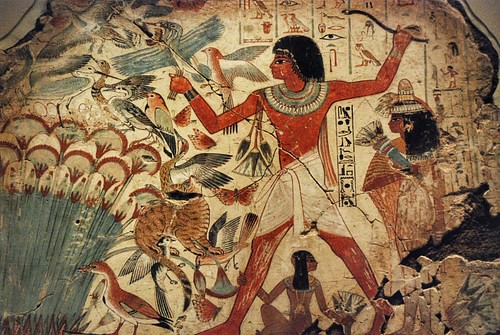
The gods were typically represented with gold skin, reflecting the belief that gods did, in fact, have gold skin. An exception to this is the god Osiris who is almost always shown with green or black skin symbolizing fertility, regeneration, and the underworld. Osiris was murdered, returned to life by Isis, and then descended to rule over the land of the dead; the colors used in his depictions all symbolize aspects of his story. Whether a scene shows a man and his wife at dinner or the gods in the solar barge, each color used had to accurately represent the various themes of these events.
Color Creation & Symbolism
The different colors below are listed with their Egyptian name following, the materials used in creating them, and what they symbolized. The definitions follow the work of Richard H. Wilkinson in his Symbolism & Magic in Egyptian Art and Margaret Bunson's Encyclopedia of Ancient Egypt, supplemented by other works.

Red (desher) - made from oxidized iron and red ocher, used to create flesh tones and symbolizing life but also evil and destruction. Red was associated with both fire and blood and so symbolized vitality and energy but could also be used to accentuate a certain danger or define a destructive deity. The god Set, for example, who murdered Osiris and brought chaos to Egypt at the beginning of time, was always represented with a red face or red hair or completely in red. One also sees this pattern in written work where the color red is sometimes used to signify a dangerous character or aspect in a story. In wall paintings and tomb scenes red must be carefully interpreted within the context of the scene. Although it was frequently used for emphasis of danger or even evil, it is also as commonly seen symbolizing life or a higher being (as in depictions of the Eye of Ra) or elevated status as in the Red Crown of Lower Egypt.
Blue (irtiu and khesbedj) - one of the most popular colors, commonly referred to as "Egyptian Blue", made from copper and iron oxides with silica and calcium, symbolizing fertility, birth, rebirth and life and usually used to depict water and the heavens. Wilkinson writes, "by the same token, blue could signify the river Nile and its associated crops, offerings, and fertility, and many of the so-called `fecundity' figures which represent the river's bounty are of this hue" (107). Statues and depictions of the god Thoth are routinely blue, blue-green, or have some aspect of blue in them linking the god of wisdom with the life-giving heavens. Blue also symbolized protection. Fertility amulets of the protector-god Bes were often blue as were the tattoos women would wear of Bes or diamond-shaped patterns on their lower abdomen, back, and thighs. It is thought these tattoos were worn as amulets to protect women during pregnancy and childbirth.
Yellow (khenet and kenit) - made from ocher and oxides originally but, from the New Kingdom (c. 1570-1069 BCE) was mixed from arsenic trisulphide and symbolizing the sun and eternity. Yellow was darkened for the golden flesh-color of the gods or lightened with white to suggest purity or some sacred aspect of a character or object. Isis, for example, is always depicted with gold skin in a white dress but, sometimes, her dress is a light yellow to emphasize her eternal aspect in a scene or story. It is thought that priests and priestesses of the gods of Egypt would sometimes dress as their deities and Wilkinson suggests that priests of the god Anubis would color their skins yellow on certain occassions to "become" the god for the event. Although Anubis was traditionally represented as black-skinned, there are a number of texts depicting him with the golden hue of the other gods.
Green (wadj) - mixed from malachite, a copper mineral, and symbolizing goodness, growth, life, the afterlife, and resurrection. The Egyptian afterlife was known as The Field of Reeds and, in some eras, as The Field of Malachite and was always associated with the color green. Wilkinson writes how green was "naturally a symbol of growing things and of life itself" and goes on to point out how, in ancient Egypt, "to do `green things' was a euphemism for positive, life-producing, behavior in contrast to `red things' which symbolized evil" (108). Green is the color of the dying and reviving god Osiris and also of the Eye of Horus, one of the most sacred objects in Egyptian mythology. In early tomb paintings the spirit of the deceased is shown as white but, later, as green to associate the dead with the eternal Osiris. In keeping with the symbolism of ressurection, green is also often used to depict the goddess Hathor, Lady of the Sycamore. Hathor was closely associated with the Sycamore tree, with renewal, transformation, and rebirth. Mummies of tattooed women suggest the ink could have been green, blue, or black and tattoos have been linked with the worship of Hathor.

White (hedj and shesep) - made from chalk mixed with gypsum, often employed as a lightener for other hues, and symbolizing purity, sacredness, cleanliness, and clarity. White was the color of Egyptian clothing and so associated with daily life but was frequently employed in artistic pieces to symbolize the transcendent nature of life as well. Priests always wore white and so did temple attendants and temple personnel taking part in a festival or ritual. The objects used in rituals (such as bowls, plates, altars, tables) were made of white alabaster. White, like the other colors, was used realistically in depicting clothing and objects of that color in real life but frequently is employed to highlight the importance of some aspect of a painting; in some cases, it did both these things. The White Crown of Upper Egypt, for example, is routinely referred to as white - and so is realistically depicted - but also symbolized the close connection to the gods enjoyed by the king - and so symbolically represents purity and the sacred.
Black (kem) - made from carbon, ground charcoal, mixed with water and sometimes burnt animal bones, symbolized death, darkness, the underworld, as well as life, birth, and resurrection. Wilkinson writes, "the symbolic association of the color with life and fertility may well have originated in the fertile black silt deposited by the Nile in its annual flooding and Osiris - god of the Nile and of the underworld - was thus frequently depicted with black skin" (109). Black and green are often used interchangably in Egyptian art, in fact, as symbols of life. Statues of the gods were frequently carved from black stone but, just as often, from green. Although black was associated with death it had no connotation of evil - which was represented by red - and, frequently appears along with green, or instead of green, in depictions of the afterlife. Anubis, the god who guides the dead to the hall of judgment and is present at the weighing of the soul's heart, is almost always depicted as a black figure as is Bastet, goddess of women, one of the most popular deities in all of Egypt. Tattoos of Bes were done in black ink and images of the afterlife frequently make use of a black background to not only accentuate the gold and white of the foreground but also symbolize the concept of rebirth.
These basic colors were often mixed, diluted, or otherwise combined to create colors such as purple, pink, teal, gold, silver, and other hues. Artists were not bound by the minerals they mixed their paints from but only by their imaginations and talent in creating the colors they needed to tell their stories.
Colors in Context
Aesthetic considerations were of great importance to the Egyptians. Art and architecture is charactized by symmetry and even their writing system, the hieroglyphics, were set down in accordance with visual beauty as an integral aspect of their function. In reading hieroglyphics, one understands the meaning by noting which direction the figures are facing; if they face left, then one reads to the left and, if up or down or right, in whichever of those directions. The direction of the figures provides the context of the message and so provides a means of understanding what is being said.
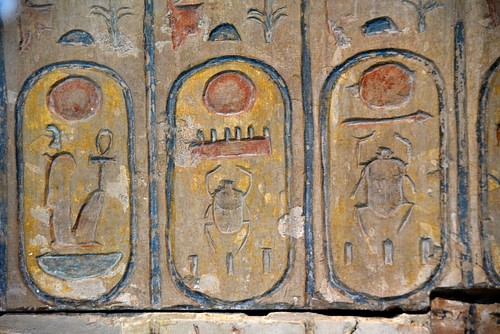
In the same way, color in Egyptian art must be interpreted in context. In a certain painting, red might symbolize evil or destruction but the color should not always instantly be interpreted along those lines. Black is a color often misinterpreted in Egyptian art because of the modern-day association of black with evil. Images of Tutankhamun, found in his tomb, sometimes depict him with black skin and these were originally associated with death and grief by the early archaeologists interpreting the finds; although the association with death would be correct, and grief did accompany the loss of anyone in ancient Egypt as today, a proper interpretation would be the association of Tutankhamun in death with Osiris and the concept of rebirth and resurrection.
White retains the same meaning in the present day that it had for the ancient Egyptians but, as noted, must also be interpreted in context. The white dress of Isis would signify purity and the sacred yet the white skirt of Set would simply be a representation of how a male Egyptian dressed. Recognizing the symbolism of Egyptian colors, however, and why they were most commonly used, allows one a greater appreciation of Egyptian art and a clearer understanding of the message the ancient artist was trying to convey.

